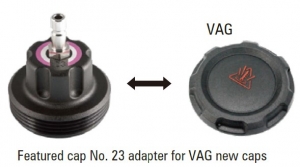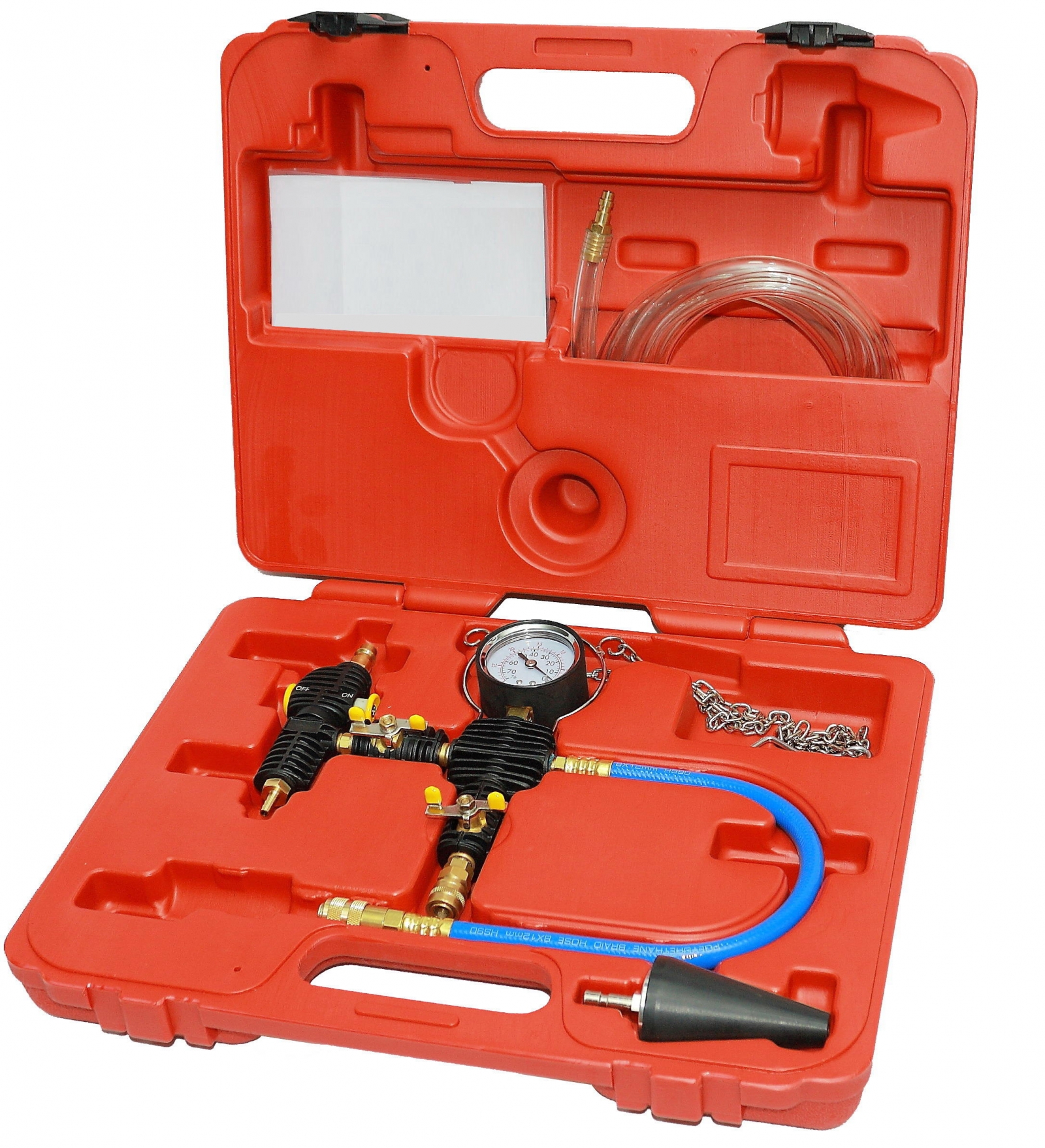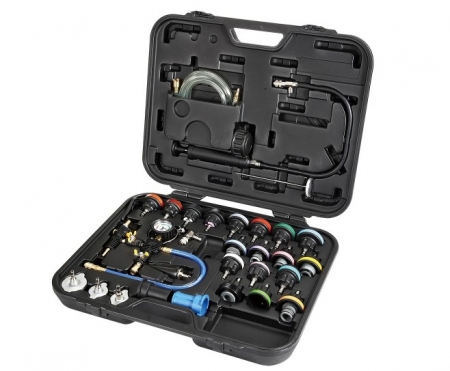30pcs Cooling System Leakage Tester and Vacuum-Type Coolant Refilling Kit
Model
KA-7230F
Specification:
- Set for testing leaks in automotive cooling system and refill new coolant by creating a vacuum in cooling system
- Includes 21 adapters (No. 3-23) for major car makes on the market
- Special 90°connector for fitting on recovery tanks located deep in the engine compartment
- Adapters and pump are made of light weight nylon 66
- Connectors (blue and black) are for testing pressure caps
Description
|
 |
Anxious No More about the surge of EV cars. EV cars will no longer have internal combustion engines, but the brake and cooling systems remain much the same as non-EV cars. KA-7230F is applicable on EV market!!
.jpg)
1. Contents:
1.1 Specification- Radiator Pressure Tester:
1.2 Specification- Vacuum Purge & Refill Tool
KA-7230V Vacuum-type Cooling System Filler Kit

2. Instruction of radiator pressure tester
2.1 check leakage in radiator system with radiator caps (material-Nylon 66)
Step 1: Remove the original radiator cap while the engine is cold.
Step 2: Choose a test cap suiting the connection type onto the radiator. Screw the cap onto the radiator opening(Fig.1).
Step 3: Connect the pump to the test cap through the quick coupling at the hose end.
Step 4: Pump until pressure is approximately 10~15psi(Fig.2). If the gauge pointer perfectly efficient; if the gauge goes down and no fluid discharges can be located, check whether the engine head gasket is worn. (CAUTION: please avoid the pressure up to the 35psi)
Step 5: Finally, release pressure through the button next to the quick coupling, and put away the device, after removing any fluid or dirt.
2.2 Check leakage on original radiator cap
Step 1: Choose the #2A or #2B with available steel radiator.
Step 2: Work the hand pump for few times, and then check the gauge reading for testing leakage. (Fig. 3)
Step 3: Follow the pressure standard shows on original radiator cap.
.jpg)
3. Instruction of vacuum purge & refill tool
3.1 Purge the air in radiator
Step 1: Please empty water from the radiator as clear as possible.
Step 2: Raise the vehicle bonnet and hand the hook in available position.
Step 3: Connect the universal radiator rubber adaptor provided or suitable radiator cap on radiator. (see fig. 4 & 5)
Step 4: Ensure the switch No.3 is ON, No.7 is OFF. (see fig. 6)
Step 5: Connect air line. Press button “ON” to allow the air goes (see fig. 7). Turn switch No.3 “OFF” when the pressure reaches 20-25 inHG (50-60cmHG) (see fig. 8). Then press button “OFF”.
.jpg)
3.2 Refill the Coolant
Step 1: Connect the coolant hose.
Step 2: It is necessary to ensure the No.3 is “OFF” before refilling coolant, then ensure coolant hose is filled with coolant.
Step 3: Turn No.7 “ON” to allow the coolant sucked into radiator. (see fig. 9)
Step 4: The work is done when the needle points will be back to “zero.”
.jpg)
Note: Please check if the radiator is fully filled with coolant or not. If not, please fill the coolant by yourself until the radiator is full of coolant.
.jpg)
1. Contents:
1.1 Specification- Radiator Pressure Tester:
| No. | Radiator Cap Application |
|---|---|
| 0 | Thermometer |
| 1 | Pressure Testing Pump with Gauge |
| 2A | Connector R123/R124(Black color) |
| 2B | Connector R123/R125(Blue color) |
| 3 | Mercedes Benz(w123, w126, w124, w201) GM(Buick) Jeep |
| 4 | Peugeot, Subaru, Chrysler, Acura, GM(Nova, Spectrum, Sprint), Mitsubishi, Nissan, Mazda, Toyota, Infiniti, GEO, Suzuki, Isuzu, Mercedes Benz) |
| 5 | Honda, Toyota, Suzuki, Mitsubishi, Chrysler, Acura, Lexus |
| 6 | Mercedes Benz (ML-class, W163, W164) GM(achiva, skylark, gramd am-1992-2002) |
| 7 | Volvo, Saab, Sterling, Citroen, Renault, Fiat, Alfa, Jeep, Mini |
| 8 | VW(Vento, T4, Passa-1996, Golf, Beetle, Sharan) |
| 9 | Audi(A4, A5, A6), BMW 345, VW(Passa-1997-2002), Porsche (Cayenne) |
| 10 | BMW (E46, E36, E34, E39, E38, E32, E90) |
| 11 | Audi, VW |
| 12 | Ford Mondeo, International, Land Rover, Opel, Ssangyong motor |
| 13 | Mercedes Benz(C-class, E-class, S-class, W140, W220, W124, W210, W211, W215, W216, W221, R230) |
| 14 | Ford Mondeo, Focus, C-MAX03 |
| 15 | Mazda (M3) |
| 16 | Mercedes A-class (W168) |
| 17 | BMW E60, E63, E64, E65 |
| 18 | VW Sharan 1.8T2.8 |
| 19 | Toyota-Rav4, Previa |
| 20 | SAAB |
| 21 | Lincoln, Mercedes, Mercury, Oldsmobile, Pontiac, Satum, Buick, Cadillac, Chevrolet, GMC, Hummer, International, Jaguar, Land Rover |
| 22 | BMW, Mini 2008 |
| 23 | Audi(A3, Q7), Porsche(Carrera), Skoda(Octavia), Seat(Toledo), VW |
| KA-7230K-QA 90° Connector For Radiator Adapters | |
1.2 Specification- Vacuum Purge & Refill Tool
KA-7230V Vacuum-type Cooling System Filler Kit

| part | Advantage |
|---|---|
| Gauge | Could turn almost 180° |
| Radiator test adaptor | Two application provides more accurate fitting
|
| on/off button | User select if the air goes |
2. Instruction of radiator pressure tester
2.1 check leakage in radiator system with radiator caps (material-Nylon 66)
Step 1: Remove the original radiator cap while the engine is cold.
Step 2: Choose a test cap suiting the connection type onto the radiator. Screw the cap onto the radiator opening(Fig.1).
Step 3: Connect the pump to the test cap through the quick coupling at the hose end.
Step 4: Pump until pressure is approximately 10~15psi(Fig.2). If the gauge pointer perfectly efficient; if the gauge goes down and no fluid discharges can be located, check whether the engine head gasket is worn. (CAUTION: please avoid the pressure up to the 35psi)
Step 5: Finally, release pressure through the button next to the quick coupling, and put away the device, after removing any fluid or dirt.
2.2 Check leakage on original radiator cap
Step 1: Choose the #2A or #2B with available steel radiator.
Step 2: Work the hand pump for few times, and then check the gauge reading for testing leakage. (Fig. 3)
Step 3: Follow the pressure standard shows on original radiator cap.
.jpg)
3. Instruction of vacuum purge & refill tool
3.1 Purge the air in radiator
Step 1: Please empty water from the radiator as clear as possible.
Step 2: Raise the vehicle bonnet and hand the hook in available position.
Step 3: Connect the universal radiator rubber adaptor provided or suitable radiator cap on radiator. (see fig. 4 & 5)
Step 4: Ensure the switch No.3 is ON, No.7 is OFF. (see fig. 6)
Step 5: Connect air line. Press button “ON” to allow the air goes (see fig. 7). Turn switch No.3 “OFF” when the pressure reaches 20-25 inHG (50-60cmHG) (see fig. 8). Then press button “OFF”.
.jpg)
3.2 Refill the Coolant
Step 1: Connect the coolant hose.
Step 2: It is necessary to ensure the No.3 is “OFF” before refilling coolant, then ensure coolant hose is filled with coolant.
Step 3: Turn No.7 “ON” to allow the coolant sucked into radiator. (see fig. 9)
Step 4: The work is done when the needle points will be back to “zero.”
.jpg)
Note: Please check if the radiator is fully filled with coolant or not. If not, please fill the coolant by yourself until the radiator is full of coolant.



